Jae-Gil Lee
MONAQ: Multi-Objective Neural Architecture Querying for Time-Series Analysis on Resource-Constrained Devices
May 15, 2025Abstract:The growing use of smartphones and IoT devices necessitates efficient time-series analysis on resource-constrained hardware, which is critical for sensing applications such as human activity recognition and air quality prediction. Recent efforts in hardware-aware neural architecture search (NAS) automate architecture discovery for specific platforms; however, none focus on general time-series analysis with edge deployment. Leveraging the problem-solving and reasoning capabilities of large language models (LLM), we propose MONAQ, a novel framework that reformulates NAS into Multi-Objective Neural Architecture Querying tasks. MONAQ is equipped with multimodal query generation for processing multimodal time-series inputs and hardware constraints, alongside an LLM agent-based multi-objective search to achieve deployment-ready models via code generation. By integrating numerical data, time-series images, and textual descriptions, MONAQ improves an LLM's understanding of time-series data. Experiments on fifteen datasets demonstrate that MONAQ-discovered models outperform both handcrafted models and NAS baselines while being more efficient.
References Indeed Matter? Reference-Free Preference Optimization for Conversational Query Reformulation
May 10, 2025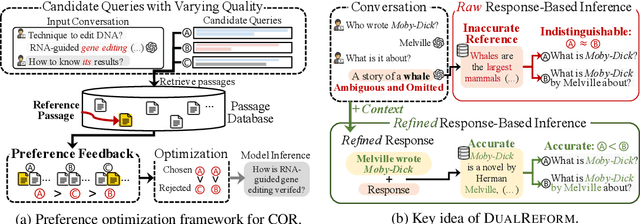
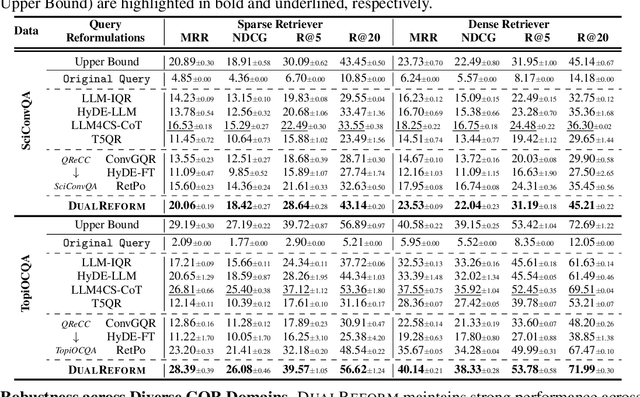
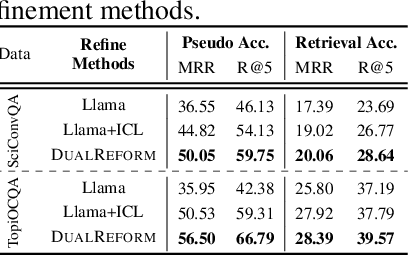
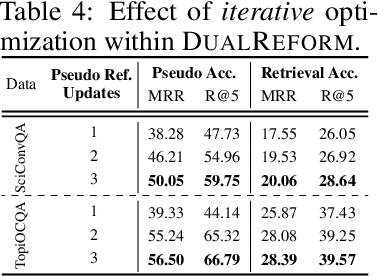
Abstract:Conversational query reformulation (CQR) has become indispensable for improving retrieval in dialogue-based applications. However, existing approaches typically rely on reference passages for optimization, which are impractical to acquire in real-world scenarios. To address this limitation, we introduce a novel reference-free preference optimization framework DualReform that generates pseudo reference passages from commonly-encountered conversational datasets containing only queries and responses. DualReform attains this goal through two key innovations: (1) response-based inference, where responses serve as proxies to infer pseudo reference passages, and (2) response refinement via the dual-role of CQR, where a CQR model refines responses based on the shared objectives between response refinement and CQR. Despite not relying on reference passages, DualReform achieves 96.9--99.1% of the retrieval accuracy attainable only with reference passages and surpasses the state-of-the-art method by up to 31.6%.
VarDrop: Enhancing Training Efficiency by Reducing Variate Redundancy in Periodic Time Series Forecasting
Jan 24, 2025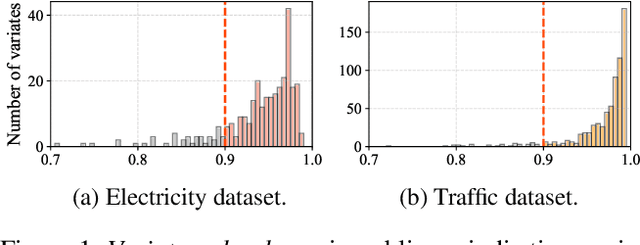
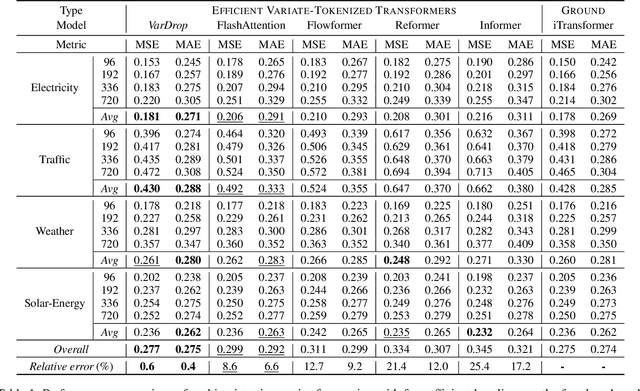

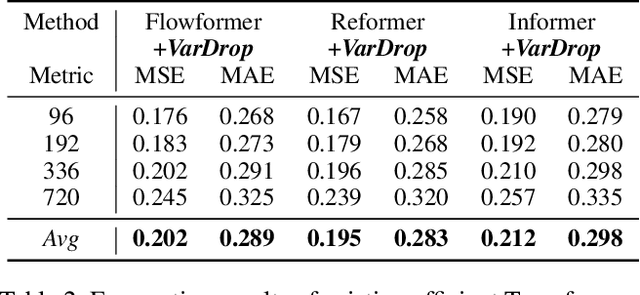
Abstract:Variate tokenization, which independently embeds each variate as separate tokens, has achieved remarkable improvements in multivariate time series forecasting. However, employing self-attention with variate tokens incurs a quadratic computational cost with respect to the number of variates, thus limiting its training efficiency for large-scale applications. To address this issue, we propose VarDrop, a simple yet efficient strategy that reduces the token usage by omitting redundant variate tokens during training. VarDrop adaptively excludes redundant tokens within a given batch, thereby reducing the number of tokens used for dot-product attention while preserving essential information. Specifically, we introduce k-dominant frequency hashing (k-DFH), which utilizes the ranked dominant frequencies in the frequency domain as a hash value to efficiently group variate tokens exhibiting similar periodic behaviors. Then, only representative tokens in each group are sampled through stratified sampling. By performing sparse attention with these selected tokens, the computational cost of scaled dot-product attention is significantly alleviated. Experiments conducted on public benchmark datasets demonstrate that VarDrop outperforms existing efficient baselines.
Active Learning for Continual Learning: Keeping the Past Alive in the Present
Jan 24, 2025Abstract:Continual learning (CL) enables deep neural networks to adapt to ever-changing data distributions. In practice, there may be scenarios where annotation is costly, leading to active continual learning (ACL), which performs active learning (AL) for the CL scenarios when reducing the labeling cost by selecting the most informative subset is preferable. However, conventional AL strategies are not suitable for ACL, as they focus solely on learning the new knowledge, leading to catastrophic forgetting of previously learned tasks. Therefore, ACL requires a new AL strategy that can balance the prevention of catastrophic forgetting and the ability to quickly learn new tasks. In this paper, we propose AccuACL, Accumulated informativeness-based Active Continual Learning, by the novel use of the Fisher information matrix as a criterion for sample selection, derived from a theoretical analysis of the Fisher-optimality preservation properties within the framework of ACL, while also addressing the scalability issue of Fisher information-based AL. Extensive experiments demonstrate that AccuACL significantly outperforms AL baselines across various CL algorithms, increasing the average accuracy and forgetting by 23.8% and 17.0%, respectively, in average.
Continuous-Time Linear Positional Embedding for Irregular Time Series Forecasting
Sep 30, 2024Abstract:Irregularly sampled time series forecasting, characterized by non-uniform intervals, is prevalent in practical applications. However, previous research have been focused on regular time series forecasting, typically relying on transformer architectures. To extend transformers to handle irregular time series, we tackle the positional embedding which represents the temporal information of the data. We propose CTLPE, a method learning a continuous linear function for encoding temporal information. The two challenges of irregular time series, inconsistent observation patterns and irregular time gaps, are solved by learning a continuous-time function and concise representation of position. Additionally, the linear continuous function is empirically shown superior to other continuous functions by learning a neural controlled differential equation-based positional embedding, and theoretically supported with properties of ideal positional embedding. CTLPE outperforms existing techniques across various irregularly-sampled time series datasets, showcasing its enhanced efficacy.
Universal Time-Series Representation Learning: A Survey
Jan 08, 2024



Abstract:Time-series data exists in every corner of real-world systems and services, ranging from satellites in the sky to wearable devices on human bodies. Learning representations by extracting and inferring valuable information from these time series is crucial for understanding the complex dynamics of particular phenomena and enabling informed decisions. With the learned representations, we can perform numerous downstream analyses more effectively. Among several approaches, deep learning has demonstrated remarkable performance in extracting hidden patterns and features from time-series data without manual feature engineering. This survey first presents a novel taxonomy based on three fundamental elements in designing state-of-the-art universal representation learning methods for time series. According to the proposed taxonomy, we comprehensively review existing studies and discuss their intuitions and insights into how these methods enhance the quality of learned representations. Finally, as a guideline for future studies, we summarize commonly used experimental setups and datasets and discuss several promising research directions. An up-to-date corresponding resource is available at https://github.com/itouchz/awesome-deep-time-series-representations.
Adaptive Shortcut Debiasing for Online Continual Learning
Dec 14, 2023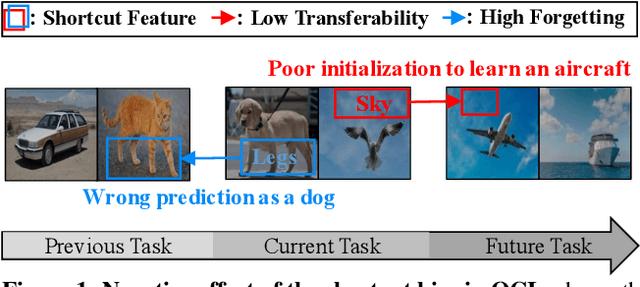
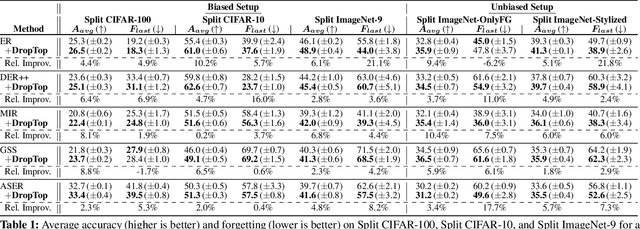
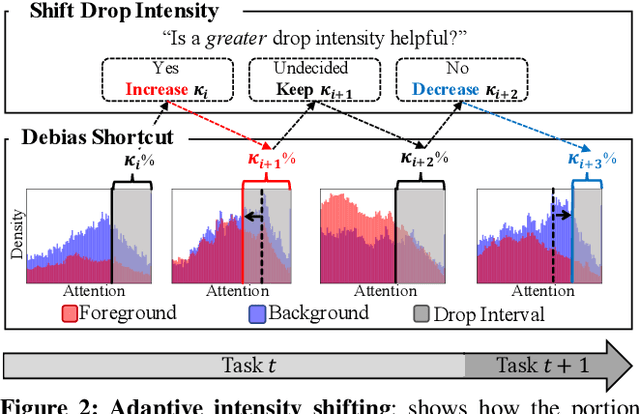
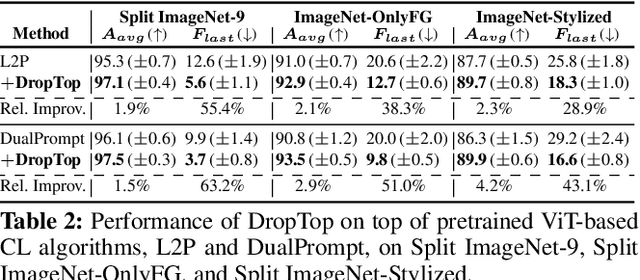
Abstract:We propose a novel framework DropTop that suppresses the shortcut bias in online continual learning (OCL) while being adaptive to the varying degree of the shortcut bias incurred by continuously changing environment. By the observed high-attention property of the shortcut bias, highly-activated features are considered candidates for debiasing. More importantly, resolving the limitation of the online environment where prior knowledge and auxiliary data are not ready, two novel techniques -- feature map fusion and adaptive intensity shifting -- enable us to automatically determine the appropriate level and proportion of the candidate shortcut features to be dropped. Extensive experiments on five benchmark datasets demonstrate that, when combined with various OCL algorithms, DropTop increases the average accuracy by up to 10.4% and decreases the forgetting by up to 63.2%.
Toward Robustness in Multi-label Classification: A Data Augmentation Strategy against Imbalance and Noise
Dec 12, 2023Abstract:Multi-label classification poses challenges due to imbalanced and noisy labels in training data. We propose a unified data augmentation method, named BalanceMix, to address these challenges. Our approach includes two samplers for imbalanced labels, generating minority-augmented instances with high diversity. It also refines multi-labels at the label-wise granularity, categorizing noisy labels as clean, re-labeled, or ambiguous for robust optimization. Extensive experiments on three benchmark datasets demonstrate that BalanceMix outperforms existing state-of-the-art methods. We release the code at https://github.com/DISL-Lab/BalanceMix.
Active Prompt Learning in Vision Language Models
Nov 27, 2023



Abstract:Pre-trained Vision Language Models (VLMs) have demonstrated notable progress in various zero-shot tasks, such as classification and retrieval. Despite their performance, because improving performance on new tasks requires task-specific knowledge, their adaptation is essential. While labels are needed for the adaptation, acquiring them is typically expensive. To overcome this challenge, active learning, a method of achieving a high performance by obtaining labels for a small number of samples from experts, has been studied. Active learning primarily focuses on selecting unlabeled samples for labeling and leveraging them to train models. In this study, we pose the question, "how can the pre-trained VLMs be adapted under the active learning framework?" In response to this inquiry, we observe that (1) simply applying a conventional active learning framework to pre-trained VLMs even may degrade performance compared to random selection because of the class imbalance in labeling candidates, and (2) the knowledge of VLMs can provide hints for achieving the balance before labeling. Based on these observations, we devise a novel active learning framework for VLMs, denoted as PCB. To assess the effectiveness of our approach, we conduct experiments on seven different real-world datasets, and the results demonstrate that PCB surpasses conventional active learning and random sampling methods.
One Size Fits All for Semantic Shifts: Adaptive Prompt Tuning for Continual Learning
Nov 18, 2023



Abstract:In real-world continual learning scenarios, tasks often exhibit intricate and unpredictable semantic shifts, posing challenges for fixed prompt management strategies. We identify the inadequacy of universal and specific prompting in handling these dynamic shifts. Universal prompting is ineffective for tasks with abrupt semantic changes, while specific prompting struggles with overfitting under mild semantic shifts. To overcome these limitations, we propose an adaptive prompting approach that tailors minimal yet sufficient prompts based on the task semantics. Our methodology, SemPrompt, incorporates a two-level semantic grouping process: macroscopic semantic assignment and microscopic semantic refinement. This process ensures optimal prompt utilization for varying task semantics, improving the efficiency and effectiveness of learning in real-world CL settings. Our experimental results demonstrate that SemPrompt consistently outperforms existing methods in adapting to diverse semantic shifts in tasks.
 Add to Chrome
Add to Chrome Add to Firefox
Add to Firefox Add to Edge
Add to Edge